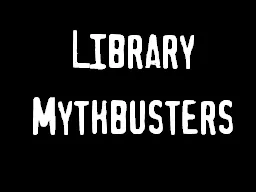PPT-Myth Busters:
Author : myesha-ticknor | Published Date : 2017-05-27
Answering Difficult Questions about Single Payer Healthcare SNaHP Annual Summit February 2015 Xin Guan Albany Medical College M3 Danny Ash Ohio State U College
Presentation Embed Code
Download Presentation
Download Presentation The PPT/PDF document "Myth Busters:" is the property of its rightful owner. Permission is granted to download and print the materials on this website for personal, non-commercial use only, and to display it on your personal computer provided you do not modify the materials and that you retain all copyright notices contained in the materials. By downloading content from our website, you accept the terms of this agreement.
Myth Busters:: Transcript
Download Rules Of Document
"Myth Busters:"The content belongs to its owner. You may download and print it for personal use, without modification, and keep all copyright notices. By downloading, you agree to these terms.
Related Documents














